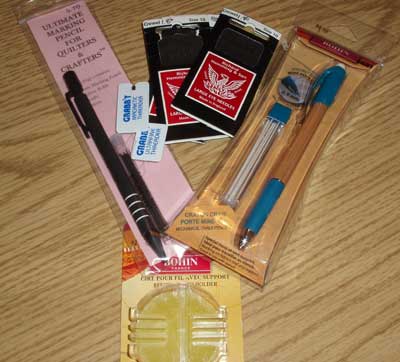Yesterday, working with my one-and-only student right now, we transferred an embroidery design onto a piece of velveteen. We managed the transfer in three steps instead of two. I’d like to show you the beginnings of the work, and tell you about our decision process along the way.

Here’s the design transferred onto the velvet. Now, you may notice that there’s been a plethora of talk on ecclesiastical needlework on here lately. This has to do with my summer embroidery “class.” In fact, I took on only one student this summer, with whom I meet twice a week. Her desire was to work together through some church embroidery projects of her choosing so that she could learn along the way, so that’s what we’ve been doing.
This particular project (it would fall under the heading of “sacred monograms,” I suppose) is 8″ across at the widest points of the quatrefoil. We’re working it on a dark burgundy velveteen (100% cotton). The velveteen will be backed by linen, once the piece is mounted on the frame.
Concerning the transfer of the design: normally, I would prefer to do this type of transfer after the ground fabric is mounted on the backing fabric on a slate frame. Unfortunately, I only have one slate frame that will accommodate this piece, and it was in use. So we went ahead and transferred the design onto the fabric as it was, and we’ll mount it later.
To transfer a design onto velvet or velveteen, the prick-and-pounce method works like a dream. I use a white-ish pounce powder for fabric this dark. After the design is pounced, the next step would be to connect the dots by drawing or painting in the lines.
We did both!

To connect the pounce dots, I used a Bohin mechanical pencil with white ceramic lead (shown on the right in the photo above). This is a terrific pencil for drawing on velvet and velveteen. The letters in the photo above are drawn this way. The pencil draws nice and smoothly, and the ceramic lead makes a very clear line. If I didn’t buy the Bohin pencil for anything at all but drawing on velvet, I’d still be happy as a clam with this pencil.
But there is a difficulty when working with any kind of chalky line on this type of fabric. While the line is sharp and visible, it won’t last long at all. It brushes right off the velvet, which is a good thing when you want to remove the transfer, but a bad thing if you don’t. So the third step of our transfer process was to paint over the pencil lines with a gold-colored opaque watercolor paint and a tiny brush.
The Logical Question: Why draw the lines in with the Bohin pencil first, before painting? Well, to tell you the truth, it was a mistake! A happy mistake, but a mistake nonetheless. I planned on just using the Bohin pencil, but we noticed right away that the design would very easily smudge off, even if the fabric is covered with a protective layer of tissue paper during the stitching. I loved the way the Bohin pencil drew on the velvet, though, and best of all, it made painting the lines in much easier, on two counts:
1. When painting over pounce dots, they tend to gum up the brush. 2. When connecting the dots in the complicated areas of the designs, it’s sometimes hard to follow the dots.
But once the design was traced on with the Bohin pencil, we could shake off all the pounce powder. No gummed up brush, and a clear design, so we could paint with confidence.
Once the paint was dry, I took a soft brush and brushed lightly over the velvet to remove the ceramic lines and any pounce residue. The whole process worked great!
True, it was an extra step, but it was worth it. My conclusion at the end of our little class: This is going to be my go-to approach for transferring designs on velvet and similar fabrics. I love it when discoveries like this happen.
So what about you? Do you ever embroider on velvet or similar piled fabrics? If so, how do you transfer your design? I’d love to hear! Feel free to leave a comment below.
Tomorrow: I’ve got a book review for you that I’m really excited about. I read this one cover-to-cover the day it arrived, and loved it. I didn’t intend to buy the book this year, but I’m glad I did. I learned a lot of Very Interesting Stuff from it and enjoyed it immensely. I’ll show you the book tomorrow, and I hope you end up liking it as much as I do!




